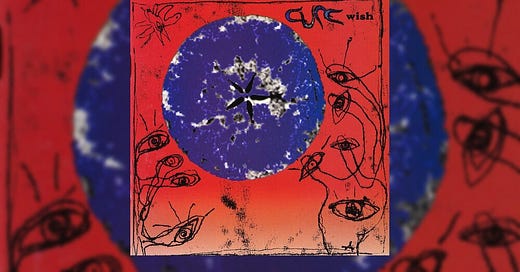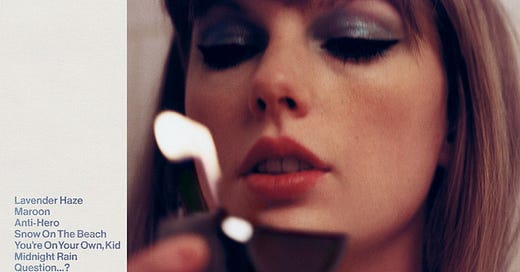
The German theologian Karl Barth once said that “It may be that when the angels go about their task praising God, they play only Bach. I am sure, however, that when they are together en famille they play Mozart.” I’m fine with the claim so long as we allow for an addendum: the saints in heaven listen to The Cure.
I will return to The Cure, the saints in heaven, and my addendum in a moment.
Last Friday, our First Reading for daily Mass gave us a famous verse from St. Paul’s Letter to the Ephesians:
In Christ we were also chosen, destined in accord with the purpose of the One who accomplishes all things according to the intention of his will, so that we might exist for the praise of his glory, we who first hoped in Christ (1:11-14).
The verse fascinates me. Paul says that the Christian exists for the praise of God’s glory. The whole of the Christian life is an act of worship. What is the cause of our lives existing as an act of worship? Paul gives an answer: we have been chosen. We are destined, marked out, for the special purpose of living lives that give praise to God. To live a life in worship of God is to act in accord with the divine will. To live a life spent praising God is to live according to the intention of God’s will.
And yet a curious development comes at the conclusion of the verse. A second answer is given to the question: What is the cause of our lives existing as an act of worship? Paul tells us that our hope is also a cause of the life we have received from God. We who first hoped in Christ are a cause of our existing for the praise of God’s glory because our hope is itself a cause of the life that we live; because of our hope, we Christians live a certain kind of life. And yet our hope, we know, is a consequence of our being chosen. What Paul describes is a life of shared causality: our lives are destined, marked out, for a special purpose and the cause of our destiny is both human and divine. God takes our freedom so seriously that he shares the very cause of our destiny with us.
The verse reminds me of how Hans Urs von Balthasar understands the interplay between divine and human freedom. Balthasar uses the categories of the dramatic arts to make sense of how human freedom is possible in a world that belongs to God. An actor in a play depends entirely upon the work of a screenwriter and a director for his or her role, lines, and orientation within the drama. Insofar as the performance of the actor depends entirely upon the work of a screenwriter and a director, the cause of the performance is the work of the screenwriter and the director. And yet, the actor makes the role original; every performance of Hamlet (a favorite example of Balthasar’s) is distinct and unique. The lines are the same. The direction of the play only allows for so much latitude and directoral creativity. And yet the Hamlet of Kenneth Branagh is wildly different from the Hamlet of Laurence Olivier. Each actor receives the grace to make the role his own, and the consequence is a singular, distinctive performance.
Balthasar says that these dramatic categories help us to make sense of our own human freedom in relation to God’s design for the world—and for our lives. He writes that:
God does not play the world drama all on his own; he makes room for man to join in the acting. It is not enough for God to involve himself with the world and with man. If there is to be an integrated interplay, man too must involve himself with God’s drama. In principle, he already has ‘access’ to it, for God has opened up the play to him, but he must go on freely to accept this fact and act on it.1
What Balthasar describes is a shared causality. We know, of course, that God is the original cause of human action. But there is a distinction between performing as an actor and performing as a marionette. Human persons are not puppets moved about by a divine pulling upon one string or another, but rather actors who through a bestowed freedom are capable of making the choice to perform the role assigned to them in a divine drama. And the shared causality between God and human persons runs so deep that every dramatic performance is its own act of creation.
I remember an occasion several years ago when a casual statement made by a psychologist speaking to some classmates and me arrested my attention. Our group conversation on the theme of obedience in the Christian life led the psychologist to say to us: “that moment when your will and God’s will unite and become one, genuine theonomy, that’s what we want in the Christian life, for you to want everything that God wants,” as he drew his hands together and interlocked his fingers as an image of the divine-human union of which he spoke. I remember thinking to myself at the time that such a life must be genuinely, radically beautiful.
And so I return to The Cure, the saints in heaven, and my addendum. There is a song on The Cure’s 1992 album Wish entitled A Letter to Elise. The song is perfect. Lyrically, the song focuses—as many perfect rock songs do—on a strained relationship. Robert Smith, of course, is no ordinary lyricist, and so is able to keenly psychologize—even spiritualize—the burden of unrequited love. To hear Smith’s plaintive yearning for an alternate life in which changed circumstance ensures that “At least I'd lose this sense of sensing something else / That hides away” is to enter deeply into the experience of a broken heart.
The music, however, deserves most of the attention in A Letter to Elise. The song begins with a drum flourish before bass and rhythm guitar establish a defining melody. Fifteen seconds into the song a chorus of synth chimes builds upon A Letter to Elise’s percussive foundation and so the essential movement of the song is set in place. The Cure eschew the typical verse-chorus-verse structure of most rock songs, electing instead for a gradual intensification of the song’s essential movement. The chorus of synth chimes disappears from the song as Robert Smith’s voice commands increasingly more attention; his syllables become elongated; the music climbs suddenly upward as the pace of the vocals slows and Smith seems almost reluctant to share with the audience anymore of his experience. Every moment of the song becomes deliberate, considered, intentional. As the lyrics turn toward talk of forsaken dreams and make-believe, Smith concedes to the band around him and a guitar solo breaks out and dominates the surrounding instrumentation.
The solo itself is a simple chord progression in a low key that rises higher and higher. The surrounding instrumentation, at first an adornment that merely complements Robert Smith’s solo, now begins to follow his guitar work ever upward. The music strives—desires—a reality beyond itself. The guitar playing quickens; the notes rise higher. The song surges toward new heights. And then it happens: the original percussive foundation of the song, synth chimes and all, comes crashing back into the musical narrative of A Letter to Elise. The moment of intersection is a genuine experience of beauty, and yet pales in comparison to the seconds that follow. These two distinct movements of the song—its original percussive foundation and the upward surging solo work of Robert Smith’s guitar—interplay with one another while the perfect musical integrity of each is retained. The whole of the sound—the whole of the experience of hearing the song—becomes demonstrably greater than the parts of which it is composed. And yet each part retains its integrity. Two distinct movements of a song embrace one another—choose one another—and the consequence is not the loss of one movement for the sake of the other but, again, a genuine experience of beauty.
The song, it seems to me, gives us an insight into the reality of divine and human freedom. The upward yearning of Robert Smith’s guitar, seeking to escape from the chains that bind it, runs headlong into the percussive foundation of the song’s original movement. And the consequence is not a struggle, nor the loss of one movement for the sake of the other, nor the generation of some new third movement that obliterates the original integrity of each, but rather a most profound moment of harmony—of union between two distinct realities that together enjoy a shared causality. A causality of what? Of beauty. Genuine, authentic beauty.
The Christian life is beautiful whenever a human will opens itself up to the workings of providence. Moments of theonomy are beautiful—more beautiful than any other, merely earthly, reality. And the saints are those who have lived a life of beauty. The rhythm, the melody of their lives has come into perfect harmony with the percussive foundation of the divine will. The upward yearning of the saints as a movement of faith enters into contact with the divine without losing its original integrity. And so the life of a saint becomes a song—a hymn—that exists for the praise of God’s glory.
Let the angels listen to Mozart.
Hans Urs von Balthasar. Theo-Drama, Vol. 2. Dramatis Personae: Man in God. p. 91.














The Cure is a great name for a band. Another great band name: Collective Soul
Thank you, Fr. Brendan for harmonizing one of my favorite bands and one of my favorite Scripture verses. I will no longer feel guilty for listening to The Cure. In all seriousness, this was a surprising but beautiful essay. I think I know what I will be listening to this evening🙂